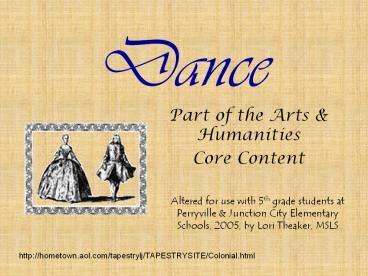Dance - PowerPoint PPT Presentation
1 / 18
Title: Dance
1
Dance
- Part of the Arts Humanities
- Core Content
Altered for use with 5th grade students at
Perryville Junction City Elementary Schools,
2005, by Lori Theaker, MSLS
http//hometown.aol.com/tapestrylj/TAPESTRYSITE/Co
lonial.html
2
True or FalseDance is always done to
music.You need a partner to dance.The first
ballet dancers were men.To dance, you need
special training and you have to be thin.
3
Dance and Movement
- What is the difference between everyday movements
and dance? - When does movement become dance?
- Movement becomes dance when the elements of dance
(space, time, and force) are intentionally
incorporated.
AH-E-2.1.31, AH-M-2.1.33
4
SPACE
- Pathways - curved lines, straight lines, zigzags,
circles, figure-eights, and many more - Shape - large, small, rounded, and angular
- Level - high, medium, low or on the floor
- Direction - forward, backwards, diagonally,
sideways - AH-E-2.1.31, 1.15, 2.23
5
TIME
- TEMPO - fast, slow, moderate
- DURATION - short, long
- BEAT - pulse of the music
- AH-E-2.1.31, 1.15, 2.23
6
FORCEthe use of energy while moving
- QUALITY-smooth, sharp, round,
- free, flowing
- ENERGY-weak, strong
- WEIGHT-heavy, light, suspended
- collapsed
AH-E-2.1.31, 1.15, 2.23
7
All dance movements can be labeled as locomotor
or nonlocomotor.
NONLOCOMOTOR-movements that do not change location
LOCOMOTOR-movements that travel
AH-E-2.1.31
8
Locomotor Movements
Dancers using locomotor movements may walk, run,
skip, hop, jump, slide, leap, or gallop. These
movements may be high (possibly indicating joy),
medium, or low (possibly indicating sadness.)
AH-E-2.1.31, 1.15, 2.23
9
Non-locomotor Movements
Dancers are using non-locomotor movements when
they stay in one place but bend, stretch, twist,
or swing their body.
10
How is a dance created?
- Dances are created by combining locomotor and
nonlocomotor movements. - A dance, like a book,
- has a beginning, a middle, and an end.
AH-M-2.1.34
11
Dance has 3 main forms
- ceremonial (religion, celebration, ritual)
- recreational (folk, social dancing, aerobic
dance) - artistic (ballet, modern, narrative, tap,
lyrical).
AH-E-2.2.32
12
Culture and Dance
- Nearly all cultures incorporate dance in some
way. - Dance is a major component of many cultures.
- Dance is often used to communicate or celebrate.
13
Some more about dance culture
- Cultures use dance in ways that are both social
and personal. - What are some examples of culture and dance you
can think of? How do those cultures use dance?
AH-E-2.2.33, A-HI-2.2.31, AH-M-2.2.32
14
Dance is also representative of time periods
- What time period do you think of when you hear
- Charleston,Virginia Reel,Swing,Disco,Bre
ak dancing, orHip Hop? - Something to think about
- How are the dances of these time periods related
to the politics of the time?
AH-H-2.3.31, AH-H-2.3.311
15
Dance in History
- Dance has played an important function in many
cultures throughout history. - Dance styles, costumes and music often reflect
the political climate of the time. - Dances such as the Locomotion, Macarena, and
even the Chicken Dance all perform a function
in our society they create a group of dancers
having fun! - AH-E-2.2.31, 1.15, 2.23, 2.25
16
Is there anything else I should know?
Dance allows the dancer or choreographer to
communicate their ideas, thoughts, and feelings
through movement. These movements are structured
and repeatable, in that they can be taught to
others.
AH-E-2.1.14, 1.15, 2.22
17
Dance is often used to tell a story
Like a story or a book, each dance has a
beginning, middle and an end. Dance is made up
movement materials, connected into phrases
and put together into a complete dance.
AH-M-2.2.31, AH-2.2.32, AH-E.2.1.31
18
Bibliography
- Resources used for this presentation include
- KETs DanceSense,
- an original Power Point presentation created by
Anna W. Martin (sent to JCES staff by HSE Pam
Clemons) - Microsoft Office ClipArt files































